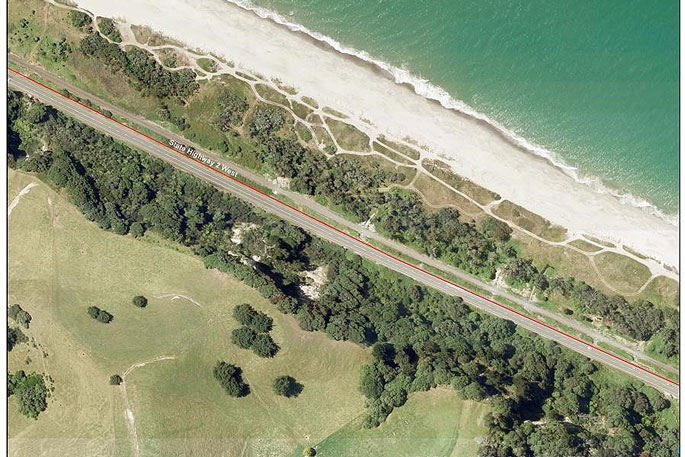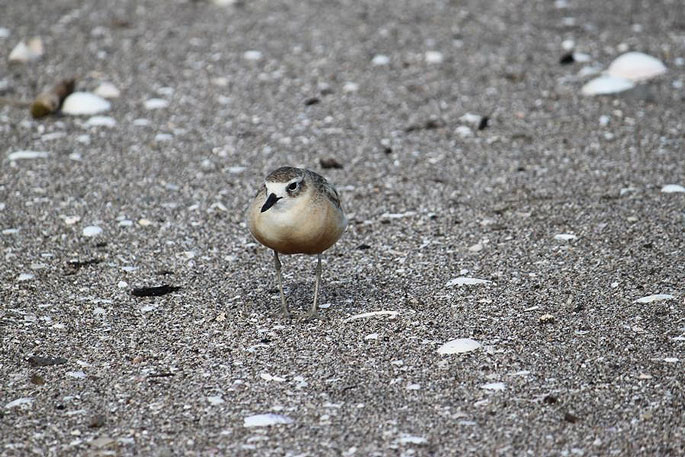Coastal care groups and local government agencies are all repeating the same message – vehicles on beaches cause damage to the natural character of our coastline.
Four-wheel drives and motorbikes harm the coastal ecosystems and biodiversity that many community groups work hard to protect and restore.
Russell Knutson, Regional Coordinator of Coast Care Bay of Plenty says that vehicles on beaches is an issue up and down the coast with his team regularly seeing the direct impacts of the damage caused.
'Our mahi is all about protecting and restoring our fragile dune ecosystems. It's devastating when we see that people have taken the shortest route to fishing/recreational locations by driving over them or simply taking a hoon in the dune with their 4WDs. This kills the plants that many endangered species nest in and live around,” says Russell.

Vehicle tracks at Mimihia Road near Maketū straights.
Chair of conservation group Maketū Ōngātoro Wetland Society Julian Fitter understands the importance of reducing vehicle traffic on beaches – key to the success of their restoration projects at Dotterel Point and Maketū Spit.
'Fencing Dotterel Point in 2013 cut down the quad bike activity and allowed the pīngao and spinifex to flourish. They're sand binding plants and provide protection for nesting birds. Because of this and the pest management we carry out, we've seen the population of native shorebirds, particularly nesting pairs of dotterels and oyster catchers, grow year on year,” says Julian.
'Reduced accessibility and new fencing at Maketū Spit has seen a rise in godwits flying in to feed before they fly back to Alaska, flocks of white fronted terns, and there's more tōrea/oyster catchers present now. We'd love to get to a place where we don't need fencing because people understand that feet and vehicles need to keep off the dunes.”

A pair of tōrea (oyster catchers) with their chick in tow at Maketū Spit. Photo: Maketū Ōngātoro Wetland Society.
Carole Long, Chair of the Te Puke Forest and Bird branch says that tūturiwhatu (dotterel) are their main concern. With only 2000 birds remaining, they're rarer than kiwi.
'They nest above the high tide mark from September to January and their nests are small, camouflaged and exposed. Vehicles shouldn't be going above the high tide mark for this very reason. When they hatch, they're not much bigger than a bumblebee and they blend in with their environment. Going down to the shoreline to feed makes them vulnerable to beach traffic too. Without the cooperation and protection of the community, dotterels are unlikely to be able to nest and rear chicks at all,” says Carole.

Godwits at Maketū Spit. Photo: Maketū Ōngātoro Wetland Society.
Western Bay of Plenty District Councils' Reserves and Facilities Manager Peter Watson explains that the issue is not just about protecting endangered species.
'Although dune plants are hardy, they cannot withstand wide flotation tyres of quad bikes, which crush and destroy them, even with a single pass. If the plants are destroyed, the dunes are exposed to wind and wave movement causing ‘blow outs' that leave them unprotected. Beach erosion also increases the risk to existing houses near the beach,' says Peter.
'If you see people being irresponsible with vehicles, quad bikes or motor bikes – then please reach out and let us know. We rely on public reports (Antenno is a great way to do this) and everyone taking responsibility when using this shared space.
'We prefer to take an education approach with the community. It's all about keeping beach users safe, respecting our coastal ecosystems and the protection it offers us and native species. It's a community effort, we all have a part to play,” says Peter.

White fronted terns in the foreground with other shorebirds at Maketū Spit. Photo: Maketū Ōngātoro Wetland Society.
Stacey Faire, a Senior Coastal Planner at Toi Moana Bay of Plenty Regional Council says that organisations like the Regional Council and district councils work hard to balance the protection of fragile coastal areas with safe public access for everyone.
'It's about striking the right balance by working alongside our district councils and coastal communities to identify local solutions to these sorts of issues, while understanding what works for all beach goers,” says Stacey.
Find out more about the rules around vehicles on beaches at www.boprc.govt.nz/vehicles-on-beaches or get in touch with Western Bay of Plenty District Council on 0800 926 732.



2 comments
Tank traps
Posted on 12-11-2022 12:38 | By CliftonGuy
Suggest putting tank traps from the dunes down to the shore at intervals. That should slow the hoons down.
Courtesy Level 1 - Signs
Posted on 12-11-2022 20:04 | By SonnyJim
Advisory signs are at beach access points but 4WD and noisy bike riders are in a world of their own - and even fishermen are not blameless when they leave fire pits containing broken beer bottles. Beach abuse will continue until the day access-blocking gates get installed - all because of a few lazy, self-righteous, and downright selfish beach users.
Leave a Comment
You must be logged in to make a comment.